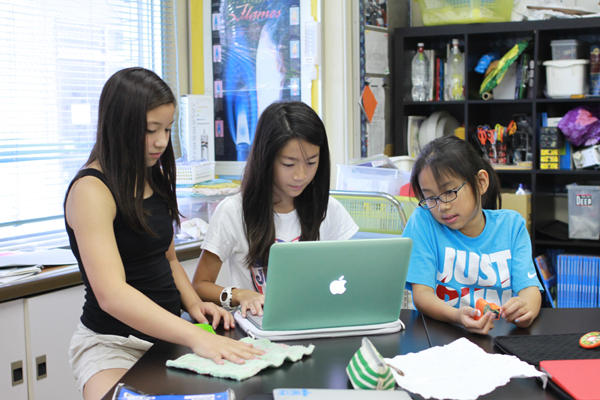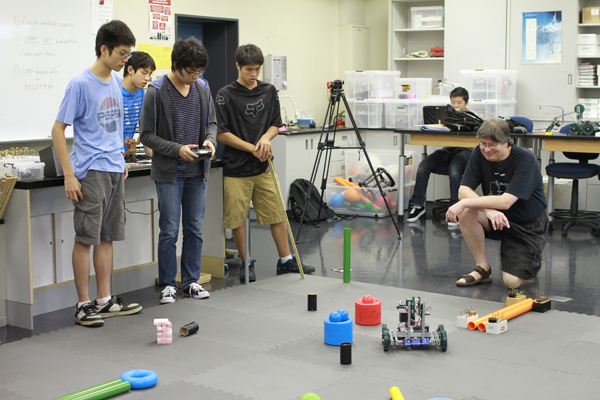The American School in Japan uses robots, apps and Skype chats to engage – and most importantly educate – its pupils. We took a look.
You don’t have to go much further than the lobby at The American School in Japan to see its High School students learning, though they aren’t in the classrooms. And there don’t seem to be any books or teachers helping them.
They are perched on the edges of desks, in the doorway of a classroom and even at the foot of a stairwell and they are in deep concentration and conversation about whatever it is on their screens. What are they doing? Maybe they are working on a video for their latest Physics project, working together on potential plans for the VEX Robotics Tournament or perhaps Skyping with students in another Global Online Academy school about their latest project?
This may be one of the oldest international schools in Tokyo, but it certainly seems to be looking forward with as much relish as it is celebrating the past. We took a walk through some of the classrooms and met some of the faculty members at ASIJ to find out more.
“It’s about giving the students the tools to become the next generation,” says Mike Moody, the elementary school’s instruction technology coach of his robotics club. “They can create and think and design and be in control – they aren’t just answering questions but are responding to challenges and, really, the class is directed by them.”
There’s a 3D printer in the corner of his room overlooking the elementary school playground and electronic cutting tools with a potential for detail that until recently was unimaginable on a table near the door. We listen to stories of fourth- and fifth-graders programming robots they have built with Lego to carry out ‘simple’ tasks; a ‘dog’ sits – literally – on command and a half built dumper truck awaits a new load of instructions.
This is a classroom where people want to be, a fact illustrated not only by the success and engagement of the students, but also by their teacher’s clear pride and belief in the children and their ability to be ready for a world in which “the jobs they will do don’t exist yet.”
The approach to computers and technology in the classrooms at ASIJ marks a shift towards a focus on IT as not simply a set of skills for a job. Many will remember IT classes being focused on office applications and word processing aptitude; not so now. Students think nothing of their Mac being as important as a pencil case and gym kit to their school day, but what does that mean for education?
The idea to move towards an integrated approach to using hardware and software that not only aids teachers and gets tasks done. It’s not just practical applications of new technology.
In part, using computers and iPads and talking about apps and videos as well as pencils and books is about spotting what students are interested in, and what they have the ability and desire to pursue, and working out how to “facilitate that and serve it through what we offer,” says Eugene Witt, Director of Information Technology.
When we meet Kevin Randall and the half of his High School robotics class who had stayed behind during recess to hone their more complex VEX robots, he told us that the problem solving process that happens when building and programming means learning happens “in context”.
It’s not the case that they sit and learn some formula and then go and enter it. They each have specific goals and will need different skills and levels of analytical and logical thinking to achieve them. And what could be more motivating than the annual VEX Robotics Competition?
Walking out of the school we saw, amongst evidence of yearly Broadway musical spectaculars, the trophies and spoils of debate championships and winning student journalism, the awards students won in previous Robotics Competitions. Now that’s exciting.
The Global Online Academy
Ed Ladd, ASIJ’s Head of School, calls the school’s membership in the Global Online Academy, which means students can take online courses from a number of prestigious partner schools in both the US and other countries, “the opportunity to further explore their passions and engage with their peers in other schools.”
With a diverse range of courses – from medical problem solving to Arabic (useful if you’ve just moved to Japan from the Middle East) – take-up in the program has been growing and there are high hopes. The idea plays into the US college model (around 6 million students in the US are taking e-learning courses) and reflects the world the students will grow into.
When we look at what’s going on and trends in the world, and we see the positive reactions to how we are getting students to think, says Eugene Witt, Director of Information Technology, “I ask myself, why wouldn’t we do something like this?”
To find out more about the robotics courses and competitions and other goings on at The American School in Japan, see www.asij.ac.jp










